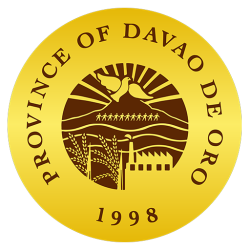- +084 817 0477
- Mon-Friday: 8:00AM to 5:00PM
Book Now
Contact Info
- Provincial Capitol Compound, Brgy. Cabidianan, Nabunturan, Davao de Oro Province, Philippines 8800
- +084 817 0477
- information@davaodeoro.gov.ph
History
- Home
- History
ORIGIN
Davao de Oro, previously named Compostela Valley, was carved out of Davao del Norte Province by virtue of Republic Act No. 8470, signed by President Fidel V. Ramos on January 30, 1998, to become the 78th province of the Philippines. On March 7 of the same year, the law was ratified through a plebiscite conducted in the twenty-two municipalities of the mother province.
Initiatives to create a separate province from Davao del Norte started in the 80s during the time of Congressman Lorenzo S. Sarmiento, Sr., the author of the division of the original province of Davao into three provinces, namely Davao Oriental, Davao Del Sur, and Davao Del Norte. Believing that the sheer size of Davao Del Norte, then the 8th largest province in the country, had greatly hindered the realization of the province’s full potentials, he filed a bill in Congress seeking to create a new province to be composed of Mawab, Maragusan, New Bataan, Nabunturan, Montevista, Monkayo, and Compostela, with the latter as the capital town. However, this was not realized until his death in the late 80s. His son, Rogelio M. Sarmiento, who became his successor in Congress, made way for the passage of the bill creating the province.
Upon consultation with the then incumbent governor of Davao Del Norte, Prospero S. Amatong, the province’s other two legislators, namely Congressman Rodolfo P. Del Rosario of the third district and Congressman Baltazar A. Sator of the 2nd district; and the other provincial and municipal officials, it was decided that the addition of four municipalities, namely Maco, Mabini, Pantukan, and Laak to the proposed province would be ideal and equitable configuration as this would make both provinces on equal footing in terms of area, population, and development opportunities. It was also decided that Nabunturan would be the capital town because of its more central location.
The name originally proposed for the province was Davao Del Norte, the former name or so it was thought, of the mother province. However, the House of Representatives’ Reference and Research Bureau which conducted the research and legal work on the creation of the province found out that the mother province continues to be officially referred to as Davao Del Norte in various official documents including the 1987 Philippine Constitution despite the passage of RA No. 6430 on June 17, 1972 renaming it as Davao Province. Tedious technical and legal issues needed to be resolved before the name could be adopted, the proposal was thus, shelved and the name finally agreed upon was Compostela Valley, referring to the great fertile plain in the heartland of the province.
The origin of the province’s inhabitants came from the ethnic tribes of the Mansaka, Mandaya, Manobo, Mangguangan, Dibabawon, Aeta, Kamayo, Davaweño and Kalagan. Similar to the history of other Mindanao provinces, majority of the present inhabitants of the province are descendants of migrants from Luzon and Visayas islands during the pre-war and post war eras. The bigger wave of immigrants came during the time of President Ramon Magsaysay wherein the policy of attraction adopted by the national government was to offer parcels of land to tenant-farmers. Although a virtual melting pot, the Visayans (mostly Cebuano-speaking) are the dominant group in Compostela Valley.

